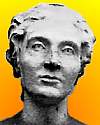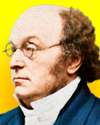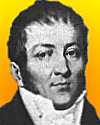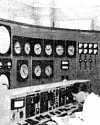 | TODAY IN SCIENCE HISTORY NEWSLETTER - 27 JUNE |
| Feature for Today |
 On 27 Jun 1831, Sophie Germain died, a French mathematician who taught herself from books and the lecture notes of friends attending the �cole Polytechnique which she, as a woman, was not permitted to attend. On 27 Jun 1831, Sophie Germain died, a French mathematician who taught herself from books and the lecture notes of friends attending the �cole Polytechnique which she, as a woman, was not permitted to attend.Using a male pseudonym, M. LeBlanc, she corresponded with Lagrange who recognised her skill, and subsequently sponsored her work. In 1816, she won a prize sponsored by Napoleon for a mathematical explanation of Chladni figures, the vibration of elastic plates. She won, although the competition was open to such great mathematicians in Paris at the time as Lagrange, Laplace, Legendre, Poisson or Fourier; but they passed the opportunity by. Sophie Germain - The Unknown Mathematician, an article in The Century Illustrated Monthly Magazine, (1894) lamented: "It is very remarkable that so great a distinction as to have received the prize of the Institute of France for a profound mathematical discussion should not have preserved the name of Sophie Germain from oblivion, but it has not done so. There are probably not a score of persons in this country who have ever heard of her, and in her own country she is not usually mentioned among its famous women." This remarkable woman's passion for mathematics came early in life - age 13. At first her parents even discouraged her, and wanted her to turn to more ladylike pursuits. Yet her resolution was too great to give up. As you will discover as you read the article. |
| Book of the Day | |
 On 27 Jun On 27 Jun Today's Science Store pick is: Everyday Life in Egypt in the Days of Ramesses The Great, by Pierre Montet, which is renowned for its accuracy and scope. His book conveys the richness and complexity of ancient Egyptian everyday life, giving insight into the lives of royalty and priests, artisans and professionals, peasants and slaves Price New $26.50. Also available Used from $0.91 (as of time of writing). Yesterday's pick: Scurvy: How a Surgeon, a Mariner, and a Gentlemen Solved the Greatest Medical Mystery of the Age of Sail, by Stephen R. Bown. For picks from earlier newsletters, see the Today in Science Science Store home page. | |
| Quotations for Today | |
 | "As to writing another book on geometry (to replace Euclid) the middle ages would have as soon thought of composing another New Testament." |
 | "It is easier to square the circle than to get round a mathematician." |
 | "In describing the honourable mission I charged him with, M. Pernety informed me that he made my name known to you. This leads me to confess that I am not as completely unknown to you as you might believe, but that fearing the ridicule attached to a female scientist, I have previously taken the name of M. LeBlanc in communicating to you those notes that, no doubt, do not deserve the indulgence with which you have responded." Explaining her use of a male psuedonym. |
| QUIZ | |
| Before you look at today's web page, see if you can answer some of these questions about the events that happened on this day. Some of the names are very familiar. Others will likely stump you. Tickle your curiosity with these questions, then check your answers on today's web page. | |
| Births | |
| |  Hans Spemann, born 27 Jun 1869, was a German embryologist who was awarded the Nobel Prize for Physiology and Medicine (1935) for his discovery of the effect now known as embryonic induction. Hans Spemann, born 27 Jun 1869, was a German embryologist who was awarded the Nobel Prize for Physiology and Medicine (1935) for his discovery of the effect now known as embryonic induction. What is the result of embryonic induction? What is the result of embryonic induction? |
 |  Alexis Bouvard, born 27 Jun 1767, was a French astronomer and director of the Paris Observatory, who is noted for discovering eight comets and writing Tables astronomiques of Jupiter and Saturn (1808) and of Uranus (1821). Bouvard's tables accurately predicted orbital locations of Jupiter and Saturn, but his tables for Uranus failed. Alexis Bouvard, born 27 Jun 1767, was a French astronomer and director of the Paris Observatory, who is noted for discovering eight comets and writing Tables astronomiques of Jupiter and Saturn (1808) and of Uranus (1821). Bouvard's tables accurately predicted orbital locations of Jupiter and Saturn, but his tables for Uranus failed. What was the result of finding irregularities in his prediction for the orbit of Uranus? What was the result of finding irregularities in his prediction for the orbit of Uranus? |
| Deaths | |
 |  Zheng Zuoxin (1906-1998) was considered the founder of modern Chinese ornithology. He wrote A Synopsis of the Avifauna of China. Zheng Zuoxin (1906-1998) was considered the founder of modern Chinese ornithology. He wrote A Synopsis of the Avifauna of China.  In a simple word, what were the subjects of his studies? In a simple word, what were the subjects of his studies? |
| |  James Smithson (1765-1829) was an English scientist who provided funds in his will "for the increase and diffusion of knowledge" in the U.S. He had inherited his fortune chiefly through his mother's family. He was a chemist and minerologist who published 27 scientific papers. James Smithson (1765-1829) was an English scientist who provided funds in his will "for the increase and diffusion of knowledge" in the U.S. He had inherited his fortune chiefly through his mother's family. He was a chemist and minerologist who published 27 scientific papers.  For what is this man remembered? For what is this man remembered? |
| Events | |
 In 1978, Seasat, an experimental U.S. ocean surveillance satellite was launched. In 1978, Seasat, an experimental U.S. ocean surveillance satellite was launched. How many orbits would the satellite make each day? How many orbits would the satellite make each day? | |
 |  On 27 Jun of a certain year, the world's first atomic power station began producing electricity in Obninsk, U.S.S.R. On 27 Jun of a certain year, the world's first atomic power station began producing electricity in Obninsk, U.S.S.R. In what decade was this day? In what decade was this day? |
 On 27 Jun 1960, chlorophyll "a" was first synthesized by Robert Burns Woodward. This molecule consists of 55 carbon atoms linked with 72 hydrogen atoms, 5 atoms of oxygen and 1 atom of a metallic element. On 27 Jun 1960, chlorophyll "a" was first synthesized by Robert Burns Woodward. This molecule consists of 55 carbon atoms linked with 72 hydrogen atoms, 5 atoms of oxygen and 1 atom of a metallic element. What is the metallic elementt? What is the metallic elementt? | |
| Answers |
When you have your answers ready to all the questions above, you'll find all the information to check them, and more, on the June 27 web page of Today in Science History. Or, try this link first for just the brief answers. Fast answers for the previous newsletter for June 26: Baron Kelvin of Largs; Charles Messier; spinning mule; Joseph Montgolfier; smallpox; CN Tower; the iron landslide and moldboard were cast in one piece. |
| Feedback |
 If you enjoy this newsletter, the website, or wish to offer encouragement or ideas, please send feedback by using your mail reader Reply button. If you enjoy this newsletter, the website, or wish to offer encouragement or ideas, please send feedback by using your mail reader Reply button. |
--
If you do not want to receive any more newsletters, Unsubscribe
To update your preferences and to unsubscribe visit this link

Δεν υπάρχουν σχόλια:
Δημοσίευση σχολίου